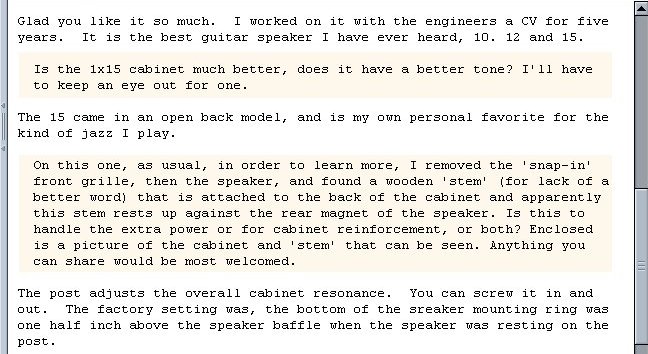
With the speaker removed, the internal components and structure of the 112-G cabinet can be seen. As seen upper left,
the cabinet is composed of ordinary plywood. Immediately noticeable is a post protruding from the back of the cabinet.
At the right, the other side of cabinets insides can be seen.
At upper left, the Cerwin Vega 12" speaker is seen. Notice the September 12th 1994 date on
the nearest support tine (seen better in enlarged view) while at upper right, a close up of the label on the back of
the speaker magnet.
Back inside the cabinet, and at upper left, the wooden post can be seen in better detail. Notice how it has threads
carved into it, looking like it is possible to turn the post in, or outwards. Then notice where the post meets the block
and you will see small remnants or traces of glue on the threads (seen better in enlarged view) which is apparently just
enough to keep the post from turning in or out. At upper right, a high quality, sealed input jack can be seen as well as
some of the internal cabinet bracing.
I had no idea what this post inside the cabinet was so I decided to email Dan and ask him. We had been talking about
his Hot Cabs over the phone prior to me purchasing one, so I shot off an email to him. It wasn't too
long before I received a reply from him which can be seen below. My first email from him was his reply once I
informed him that I acquired a Hot Cab, while the second reply answered my questions. Although it looks as though he
was calling me Roger - this was actually the end of an entirely different conversation that he was following up on
and he was answering me back stating 'Roger....' as in 'roger that transmission'. This kind of thing. As usual, notice
the letter D standing in for his name as he closes his letter, or email. Dan never did use spell checkers much.

I then informed him how well, I liked the 112-G Hot Cab I received, then proceeded to ask him about the post.
My questions can be seen in the beige colored background.

For any that might seem confused after reading this - what Dan was saying, is that the factory setting was such that
when the speaker was resting on the post & not screwed down in place - that the bottom side of the speaker mounting
ring would be raised 1/2" above the front of the cabinet (or baffle) - as seen in the photos above.
Although the speaker is free floating on the post, just insert and tighten down the allen screws that secure the
speaker to the cabinet. Make small turns while constantly moving from one screw to the next. Eventually the speaker
mounts flush with the front of the cabinet and the pressure applied against the post is transferred to the cabinet,
giving it the acoustical properties, or 'cabinet response' that Dan was talking about.
continue
menu
Names and images are TMand © Dan Armstrong / Ampeg. All rights reserved.
All other names and images are TMand © of their respective owners. All rights reserved.
|
| |

